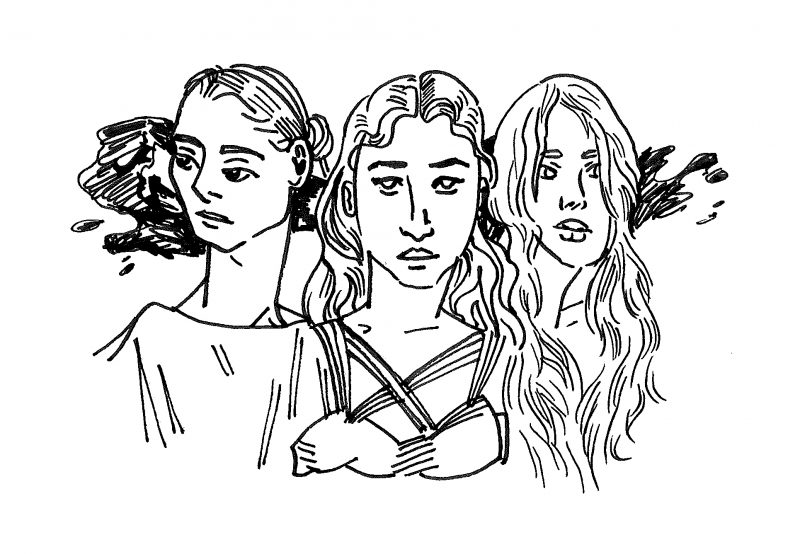It’s a familiar story for fans of the 1977 film “Suspiria.” A naïve American girl named Susie Bannion joins a secretive and secluded dance academy that just happens to be run by witches, including the enigmatic Madame Blanc. Maggots rain from the ceiling, girls faint from nightmares of creatures disfigured beyond recognition, an unearthly shade of red pervades director Dario Argento’s cinematography and absolutely no one knows what is happening at any moment.
Upon its release, the original “Suspiria” was derided by New York Magazine critic John Simon as “a horror movie that is a horror of a movie, where no one or nothing makes sense: not one plot element, psychological reaction, minor character, piece of dialogue or ambience.” But as I discovered when I walked into a sold-out movie theatre for the 2018 remake on Halloween night — reader, I bought the final ticket — that’s why it’s a cult classic.
The film is beloved for its whimsical oddness — such as the MC Escher-based architecture — more than anything. Director Luca Guadagnino, known for “Call Me by Your Name,” fleshes out the remake both historically, by setting the plot in 1977 West Berlin, and structurally, by giving the characters more depth and increasing the runtime to a terrifying two and a half hours. It is, however, the atmospheric qualities Guadagnino brings that elevate the remake far beyond the original.
With a gloriously convoluted plot structure called “Six Scenes and an Epilogue in Divided Berlin,” the 2018 remake attempts to add historical allegory, analogizing the secrets of the dance academy with similarly unacknowledged historical atrocities in Germany. Patricia, a student who runs away from the academy in the original, is reimagined as a member of the leftist Red Army Faction, and the climactic dance sequence is called “Volk,” a reference to German populism.
The historical elements are oddly handled. I appreciated the emphasis on believing women’s experiences (the witches’ coven has been interpreted by critics as a dispensary of vigilante justice and a reimagining of the ‘divine feminine’ as a respite from fundamentally broken institutions), but I was disappointed by the Holocaust and German history’s relegation to a side-plot; the directors seemed to have good intentions, but it felt borderline disrespectful at times. The film shines where it analyses womanhood and the revolutionary power of female rage.
The original film’s Italian “giallo,” or detective-thriller, genre provides a refreshing change from the typically sexualized nature of female-focused horror — there’s minimal romance, and Susie is an active agent in solving the mysteries at her school. The new version displaces some of the action onto a male character but adds an arguably romantic subplot between Susie and Madame Blanc and subverts the audience’s ideas about whose side we’re on — dancers versus the witches — instead of demonizing powerful women, something a lot of horror films fall into.
The 1977 “Suspiria” is an abstract dreamscape, but it’s also known for one of the most violent scenes in horror movies. The remake matches the original’s violence in one of its early scenes in which Susie, played by Dakota Johnson, is manipulated by the witches to torture a fellow dancer. I had to look away for the duration of this scene; if you’re easily disturbed by body horror, make sure you you don’t order something heavier than popcorn.
Beyond this scene, however, the new “Suspiria” has been dismissed by critics as not very scary. As a Slate review laments, “Guadagnino and screenwriter David Kajganich’s addition of a plot involving West German terrorists and, sigh, the Holocaust underscores how much more terrifying humanity is compared with a group of women barely running a dance school with a terrible attrition rate and an accidental, last-minute star performer.” While I agree with this review somewhat, I think that this review fundamentally misunderstands the nature of Suspiria’s horror.
The new film may not be frightening in the traditional horror-movie sense, but Guadagnino succeeds in creating unnerving aesthetics, where disturbing elements literally ooze from seemingly innocuous surfaces. Madame Blanc, played by Tilda Swinton, tells Susie in one of the film’s most effective scenes, “There are two things that dance can never be again: beautiful and cheerful. Today, we need to break the nose of every beautiful thing.”
Furthermore, the new film and the original both revel in “camp” aesthetics, which is most evident in the new film’s treatment of the witches, who do crosswords, cackle mysteriously, and stare at each other intensely across tables at fancy restaurants. Personally, I loved that. Finally, they create a dichotomy between more experimental, art house horror and more traditional, jump-scare-reliant horror that doesn’t give enough credit to the genre’s versatility.
The 2018 version of “Suspiria” is still showing in several San Antonio theaters, and you can find the original for free in Coates Library. If you like horror and are also a bit of an art house film nerd like myself or are just looking for something new, I would highly encourage you to watch it. It might just cast a spell on you.







